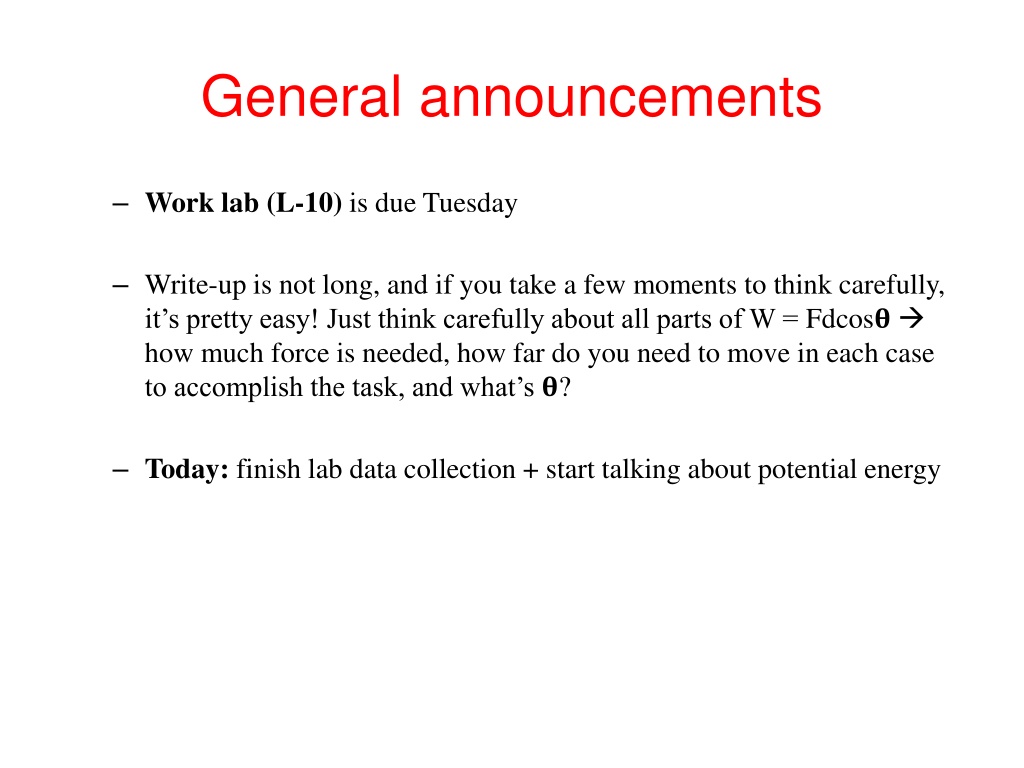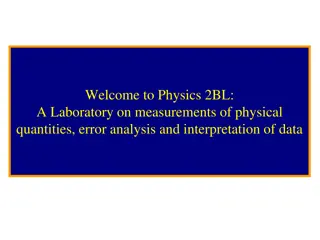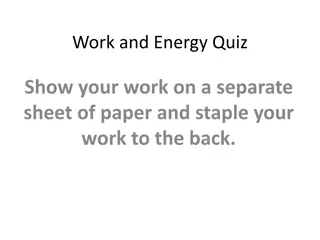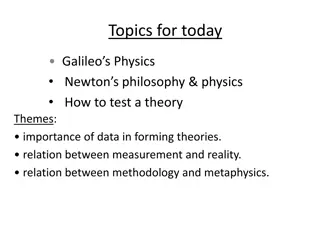Understanding Work and Energy in Physics Experiments
Dive into the world of physics experiments with a focus on work, forces, and energy. Learn about calculating work done, analyzing forces like friction, and understanding kinetic energy in practical scenarios. Explore the concepts through hands-on labs and real-world examples to enhance your understanding of physics principles.
Download Presentation

Please find below an Image/Link to download the presentation.
The content on the website is provided AS IS for your information and personal use only. It may not be sold, licensed, or shared on other websites without obtaining consent from the author. Download presentation by click this link. If you encounter any issues during the download, it is possible that the publisher has removed the file from their server.
E N D
Presentation Transcript
General announcements Work lab (L-10) is due Tuesday Write-up is not long, and if you take a few moments to think carefully, it s pretty easy! Just think carefully about all parts of W = Fdcos? how much force is needed, how far do you need to move in each case to accomplish the task, and what s ?? Today: finish lab data collection + start talking about potential energy
F Consider: a 100-N force F applied at above the horizontal drags a 20-kg box 3.0 meters across a rough surface whose coefficient of kinetic friction is . Derive an expression for the work done by the various forces acting on the box. 60o q mk mk=.15 gavity: F N q fk=mkN normal: mg 12.)
F friction: q To deal with friction, we need the normal force. Using N.S.L. in the vertical: N -mg+Fsinq = may N = mg-Fsinq mk Fy: 0 F N q So fk=mkN -1 mg 13.)
F Notice the units of work are newton- meters, which are joules, an energy quantity. So what must the significance of a negative work calculation like friction s be? Negative work acts to pull energy out of the system (which means that positive work must act to put energy into a system). q mk F N F s work: q fk=mkN mg 14.)
Box on an incline A 5-kg box sits at the top of a 6-m high ramp that is inclined at 30 above the horizontal. For this ramp, ??= 0.3 and ??= 0.15. 6 m 30 Does the box stay in place or slide? ( )sin30o= 24.5 nts ( ) 9.8 m/s2 mgsinq= 5 kg Gravity is pulling down with force: Maximum static frictional force is: ( )cos30o=12.73 nts ( )= .3 ( ) 5 kg ( ) 9.8 m/s2 msN =msmgcosq Clearly gravity wins out and the body slides!
A 5-kg box sits at the top of a 6-m high ramp that is inclined at 30 above the horizontal. For this ramp, ??= 0.3 and ??= 0.15. N Fk=mkN d mg 6 m 30 Assuming it slides, how much work is done by each force acting on the box by the time it reaches the bottom of the ramp? Also, what is the net work done during the motion?
A 5-kg box sits at the top of a 6-m high ramp that is inclined at 30 above the horizontal. For this ramp, ??= 0.3 and ??= 0.15. N Fk=mkN d mg 6 m 30 How fast is the block traveling when it gets to the bottom of the incline? AND HERE IS WHERE WE NEED A LITTLE HELP . . .
Work and energy This expression is called the Work-Energy Theorem The quantity 1 Thus, we can rewrite this equation as: 2??2 represents the kinetic energy of an object. The work-energy theorem in this form tells us that when net work is done on an object, the object s kinetic energy will change.
A 5-kg box sits at the top of a 6-m high ramp that is inclined at 30 above the horizontal. For this ramp, ??= 0.3 and ??= 0.15. N Fk=mkN d mg 6 m 30 How fast is the block traveling when it gets to the bottom of the incline? So now we can answer our question with the help of the Work/Energy Theorem! Wnet= DKE =1 0 ( ) 2-v1 2 2m v2 2 5.77 J ( 5 kg ( ) 2Wnet m v2= = ) 2 = .46 m/s
Problem 5.6 with friction A man applied a horizontal force of 150 N to push a 40.0 kg crate 6.00 m on a rough surface. If v is constant, (a) What is the work done by the 150 N force? (b) What is the coefficient of kinetic friction? F = 150 N d = 6 m ????= ? ? ????= ? ????= 150 N 6.00m cos 0 ????= 900 ? ? ???? ????= ????+ ?????????= 0 ????= ????????? 900 ? = ???? cos 180 ??=900 ? ???= 0.383 Because v is constant, we know Wnet = 0 (no change in KE). We also know ay is 0, so FN = mg. So:
So Consider . . . q A plane moving with velocity v at an angle with the horizontal is h meters above the ground. A coke bottle is released out its window. How fast is the bottle moving just before it hits the ground? v q h The Work/Energy Theorem might work, except the work gravity does is going to change from point to point. So what to do?
Bit of Slight of Hand A ball moves from position 1 at to position 2 at as shown on the sketch. How much work does gravity do in the process? position 2 y1 y2 y2 We can derive the work quantity using the standard approach and noting that the direction of the gravitational force is opposite the direction of the displacement of the ball as it moves upward. Doing so yields: position 1 y1 y = 0 -1 28.)
section 4 We next need to derive the amount of work gravity does on the ball as it traveled from position 1 to position 2 along the convoluted path shown to the right. Note that I ve broken the sections into mini-sections for easy analysis. --in section 1 and 4, gravity does no work done as the force is perpendicular to the displacement through those sections; --in section 3, gravity s work is negative (force down, motion up) whereas in section 5, its work is the same magnitude but positive, so these two add to zero. --in section 2, gravity does negative work in the amount calculated in the previous section . . . section 5 section 3 position 2 section 2 y2 position 1 section 1 y1 Conclusion: All that matters when doing a work calculation with gravity is where you start and where you end with the path making no difference at all. 29.)
Force fields that act this way, whose work calculations are PATH INDEPENDENT, are called CONSERVATIVE FORCES. Note that a conservative force does NO NET WORK around a closed path (another example beyond the visual shown to the right is the work gravity would do as the ball went from position 1 out and back to position 1). positive works This means non-conservative forces do work that is not path dependent. The classic example of this is friction. negative works Pick any point and begin summing the work quantities back around to that point. If the force is conservative, the sum will be zero (same amount of positive as negative work done, net) 30.)
If all that matters is where you start and where you end when doing a work calculation for a conservative forces like gravity, wouldn t it be cool if we could define a function U that would assign a number to and a number to that would be such that when you took the difference between the two, you got the amount of work done by the field as you proceeded between the two points? (And the answer to that question is, Yes, definitely very cool. ) position 2 y1 y2 y2 position 1 y1 Well, that s exactly what we stumbled onto when we did the work calculation using the conventional approach on on gravity. Because looking at our solution, we got: Wgrav= - mgy2-mgy1 ( ) mgy with looking very much like such a function (almost there s a negative sign out in front of the difference, but that s OK, the general idea still holds) 31.)
Functions that do this kind of thing, that allow you to determine how much work a conservative force field does on a body moving from one point to another in the field simply by evaluating the function at the endpoints of the displacement, are called POTENTIAL ENERGY FUNCTIONS. position 2 y2 position 1 The symbol used for potential energy functions is a U, and the potential energy function for gravity when near the earth s surface is: Ugrav= mgy Furthermore, the relationship between potential energy functions and work calculations is: Wcons.force= -DU y1 32.)
So using our potential energy function for gravity (near the surface of the earth) on our ball problem, we could write: position 2 U1= mgy2 Wgrav= -DU = - U2-U1 = - mgy2-mgy1 ( ( ) ) y2 position 1 U1= mgy1 In short, if you know a force field s potential energy function, in almost all instances it s a LOT easier to do a work calculation for the force using its potential energy function than trying to get the result using . y1 33.)
Whats important to understand is that potential energy is a mathematical contrivance created to do ONE THING and ONE THING ONLY to determine how much work a conservative force does on a body moving from one point to another in the field. The ONLY THING you will ever use a potential energy function for will be to do WORK CALCULATIONS, and the only way you will ever use that function will be by taking the difference of the evaluation of the function at the motion s endpoints, then sticking a negative sign in front of that value. 34.)
Lets see how well youve understood this. A block is about to fall from the position shown to the level of the table top. Little Billy says the block starts out with potential energy . Little Missie says, Oh, no, it has potential energy equal to . Who is right? position 2 y2-y1 mgy2 mg y2-y1 ( ) position 1 y2 Answer: Both are making statements that could be correct. How so? As there is no preferred F = 0 position for gravity near the surface of the earth, there is no preferred position to make the gravitational potential energy equal to zero. You can see that in its definition. Mgy is dependent upon where you put y = 0, which is dependent upon where how you define your coordinate axis. y1 35.)
As the axis is currently set up with y = 0 at the floor, the potential energy at position 2 is, indeed, as Little Billie stated. But potential energy functions are only meaningful in pairs because minus their difference between two points is what is related to work calculations. Using Little Billie s defined value as it was meant to be used, then, the work done on the body as it went from position 2 to position 1 becomes: position 2 U2= mgy2 position 1 y2 y1 ( ) Wgrav= - U2-U1 = - mgy1-mgy2 ( = mgy2-mgy1 ( ) ) (done for comparison later) Little Billie seems vindicated. 36.)
But Little Suzie is an iconoclast. She decides to make her y = 0 position the top of the table (i.e., at position 1). So in her rendition, her sketch looks like the one shown to the right and her work done calculation for the body as it moves from position 2 to position 1 looks like: position 2 y2-y1 y = 0 position 1 ( ( ) Wgrav= - U2-U1 = - 0-mg y2-y1 = mgy2-mgy1 ( ) ( ) ) This is the same value Little Billie got in his calculation (shouldn t be surprising as the motion hasn t changed even if the coordinate axis has). 37.)
Conclusions: 1.) Although it is commonly done, making statements like, The body at position 2 has potential energy in the sense that it can potentially pick up kinetic energy is a little bit dangerous. Why? Because if we take the zero level to be the tabletop, the gravitational potential energy at that point, BY DEFINITION, is ZERO. With that, it makes no sense to claim that there is NO potential for a body to pick up kinetic energy if it were to drop from that level to the ground. In fact, that work calculation would look like: position 2 y2-y1 y = 0 position 1 yg= -y1 ( ( ) Wgrav= - Ug-U1 ) ( )-0 = - mg -y1 = mgy1 38.)
Gravitational PE, aka U From these examples (and many others like them) we can see that the work done by gravity as an object moves between heights is independent of the path taken. That is, work done by gravity only cares about the starting and ending points and the height differential between them. This makes gravity a conservative force Path independent Energy is turned into another form within the system ? = ??? This leads us to the idea of gravitational potential energy, U Near the Earth s surface, the gravitational potential energy of any object of mass m at a height y above a reference point can be found by:
Gravitational PE You get to decide where y = 0 is! Depending on the problem, it might be the ground, a table, the lowest point the object reaches, the highest point, whatever. It doesn t matter where y = 0 is as long as you indicate where it is, and you keep it consistent. It s the change of position that s important. Gravitational PE is also measured in Joules, just like kinetic energy and work. Gravitational PE can turn into kinetic energy and vice versa without being lost as long as there are no outside forces doing work. This is part of being a conservative force.
How We Got Here! We started by noticing that a force component acted along the line of a body s motion will affect the magnitude of the body s velocity. We multiplied the force component and displacement to generate the scalar quantity called work. Using Newton s Second, we derived a relationship between the net work done on a body and the change of the body s kinetic energy. This was called the work/energy theorem. We then noticed that there are forces whose work done does not depend upon the path taken as a body travels between two points whose work is end-point independent (friction was clearly not one of these forces). In such cases, we developed the idea of a function that, when evaluated at the endpoints, would allow us to determine how much work the field did as a body moved between the points . . . which is to say, we developed the idea of potential energy functions. So now it s time to take the last step, starting with the work/energy theorem. 2.)
Consider a body moving through a group of force fields on its way from Point 1 to Point 2. What does the work/energy theorem tell us about the body s motion? The net work done will equal the sum of all the bits of work done by the various pieces of force acting on the system. Denoting each force with a letter, this can be written as: Wnet=DKE WA+ WB+ WC+ WD+ WE= KE2- KE1 Assume : --the forces that produce work A and work B are conservative with KNOWN potential energy functions. --the force that produces work C is conservative but with an UNKNOWN potential energy function. --the forces that produce work D and work E are non-conservative, don t HAVE potential energy functions and need to be determined using either or . 3.)
For work A and work B, we have potential energy functions. So . . . WA= -DUA = - U2,A-U1,A ( WB= -DUB = - U2,B-U1,B ( and ) ) For work C, D and E, we can t use potential energy functions, either because we don t know them or because they are non-conservative forces and don t have them. With this, the work/energy theorem becomes: 4.)
Rewriting this so the signs are easy to see, we get . . . ( ) ( ) -UA,2+UA,1-UB,2+UB,1+ + - UB,2-UB,1 + - UA,2-UA,1 = KE2-KE1 Wextraneous = KE2-KE1 Wextraneous What we are left with are a bunch of potential energy terms (U terms) and at least one kinetic energy term evaluated at time , and a similar group of terms evaluated at time . If we put all of the terms associated with the state of the system at the beginning of the time interval, at point in time 1, on the left side of the equal sign, and put all of the terms associated with the state of the system at the end of the time interval, at point in time 2, on the right side of the equal sign (leaving the extraneous work terms alone), we get: t1 t2 KE1+U1,A+U1,B+ = KE2+U2,A+U2,B Wextraneous 5.)
Rewriting this in its most succinct form, allowing for the possibility that you could have more than one object with kinetic energy in a system at a given instant (think Atwood Machine), we get: + + = + KE1 U1 Wextraneous KE2 U2 If we call the sum of all the kinetic energies and all of the potential energies at a point in time the mechanical energyE at that time, we can make this relationship even more abbreviated as: E1+ = E2 Wextraneous This is the absolute simplest form of this relationship. 6.)
In summary, this relationship states that if there is no work being done by extraneous forces in a system (remember, a force that does extraneous work is one whose work calculation can t be done using a potential energy function), then the total mechanical energy at time 1 will equal the total mechanical energy at time 2. In other words, the total mechanical energy does not change, is conserved and 0 E1+ = E2 )= Wextraneous ( ( ) + + KE1 U1 KE2 U2 Note 1: At time 1, the distribution of potential and kinetic energies may be different than at time 2. The claim is that the SUM of those two types of energy will always be equal. Note 2: How to conceptually understand this? If there is extraneous work being done, that will simply increase or decrease the initial mechanical energy in the system giving us the final mechanical energy in the system. 7.)
Conservation of Energy! What this relationship says is that if there is no work being done by extraneous forces in a system (remember, an force that does extraneous work is one whose work calculation can t be done using a potential energy function), then the total mechanical energy at time 1 will equal the total mechanical energy at time 2. In other words, the total mechanical energy does not change and is conserved. Note 1: At time 1, the distribution of potential and kinetic energies may be different than at time 2. The claim is that the sum of those two types of energy will always equal the same number. Note 2: If there is extraneous work being done, that will simply increase or decrease the initial mechanical energy in the system to give us the final mechanical energy in the system.
Problem 5.25 A daredevil on a motorcycle leaves a ramp with speed 35.0 m/s. If the speed is 33.0 m/s at the peak of motion, what is the maximum height the motorcycle reaches (relative to the end of the ramp)? Ignore friction and air resistance in this problem. See solution on MyPoly























